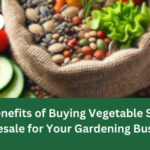As a passionate gardener, I have always been fascinated by the idea of organic seed saving. Not only does it allow me to preserve the heirloom varieties that I have grown to love over the years, but it also helps me contribute to environmental conservation.
Organic garden seed saving is a sustainable practice that involves collecting and storing seeds from your garden plants for future use. By doing so, you can maintain genetic diversity, adapt to local growing conditions, and promote ecological balance.
Key Takeaways:
- Organic garden seed saving is a sustainable practice that promotes environmental conservation.
- It enables gardeners to preserve heirloom varieties, maintain genetic diversity, and adapt to local growing conditions.
Understanding the Importance of Seed Saving
As an organic gardener, one of the key practices that I’ve found to be valuable is seed saving. Not only does it help me to preserve heirloom varieties, but it also ensures that I maintain genetic diversity in my garden. This enables me to adapt to local growing conditions and foster sustainable gardening practices.
For those of you who may not be familiar with the idea of seed saving, it’s simply the process of collecting and preserving seeds from your garden for future use. By saving seeds, we can maintain the genetic diversity of our plants, produce hardier plants, and save money on purchasing seeds every year.
To get started with seed saving, it’s important to choose the right plants. Select open-pollinated or heirloom varieties, as these will produce seeds that will come true to type. Hybrid varieties may produce seeds, but they may not be true to the parent plant.
Once you’ve identified the plants you want to save seeds from, it’s important to ensure proper pollination. This can be done by manually pollinating plants or by providing habitat for pollinators such as bees and butterflies. Properly pollinated plants have a higher chance of producing viable seeds.
When it comes to handling seeds, it’s important to allow them to mature fully on the plant before collecting. Harvest them on a dry day and store them in a cool, dry place out of direct sunlight. Be sure to label and organize your seeds for easy access in the future.
Practical Tips for Sustainable Seed Saving
Here are a few practical tips to help you get started with sustainable seed saving:
- Start with easy-to-save seeds such as lettuce, beans, or peas
- Avoid collecting seeds from diseased plants, as this can lead to contaminated seeds
- Rotate your crops to prevent pests and diseases from building up in the soil
- Consider sharing your saved seeds with other gardeners
With these tips in mind, you can begin to save your own seeds and promote sustainability in your garden. Happy gardening!

Techniques for Organic Seed Saving
Seed saving is a fascinating and rewarding process that allows gardeners to preserve heirloom varieties, maintain genetic diversity, and adapt to local growing conditions. To successfully save seeds, there are several techniques you should keep in mind.
First, it’s important to select the right plants for seed saving. Choose plants that produce healthy, vigorous offspring and those with traits you want to preserve. It’s also important to ensure proper pollination, which can be achieved by separating plants by distance or time, hand-pollinating, or using isolation techniques.
Next, it’s crucial to handle seeds properly for successful preservation. For dry-seeded plants, allow the seeds to fully mature and dry on the plant before harvesting. For fleshy fruits, extract the seeds and clean them thoroughly. With both types, be sure to dry the seeds thoroughly before storing them.
Step-by-Step Guide to Saving Organic Seeds
| Seed Type | Harvesting | Cleaning | Drying | Storage |
|---|---|---|---|---|
| Dry-seeded plants | Allow seeds to fully mature and dry on the plant before harvesting | Remove any debris or chaff using a fine mesh screen | Spread seeds out in a single layer on a dry surface in a well-ventilated area | Store in a cool, dry place in labeled envelopes or glass jars |
| Fleshy fruits | Extract seeds and place in a container of water to ferment for a few days until the seeds sink to the bottom | Remove seeds from pulp and rinse thoroughly to remove any remaining debris | Spread seeds out in a single layer on a dry surface in a well-ventilated area | Store in a cool, dry place in labeled envelopes or glass jars |

By following these techniques for organic seed saving, you can ensure the purity of saved seeds and support a sustainable future for your garden and the environment.
Storing Your Garden Seeds for Longevity
Proper storage of garden seeds is crucial to maintain their viability and longevity. After harvesting and cleaning the seeds, the next step is to dry them completely. Spread the seeds on a tray or a screen for a week or so to ensure they are completely dry. This will prevent the seeds from molding or rotting during storage.
Once the seeds are dry, they can be stored in airtight containers. Glass jars with tight-fitting lids or plastic bags with zip-lock seals work well. Be sure to label each container with the name of the plant, date of harvest, and any other relevant information. This will help you keep track of the seeds and their viability.
It’s best to store the seeds in a cool, dry, and dark environment. A dark cupboard or a refrigerator are ideal storage places. However, it’s important to avoid storing the seeds in a freezer, as the moisture can reduce their viability.

Remember to check on your stored seeds periodically, especially during the first year. This will allow you to remove any seeds that show signs of mold or moisture damage.
Properly stored garden seeds can last for several years, allowing you to use them in future seasons. This not only saves you money, but also ensures that you are using seeds that are adapted to your growing conditions. So, take the time to store your garden seeds properly and enjoy a sustainable harvest year after year.
Seed Saving Challenges and Solutions
As much as seed saving is a rewarding activity, it comes with several challenges that can affect the viability and purity of saved seeds. One of the primary issues is cross-pollination, where pollen from one plant fertilizes another, leading to seeds with a mixture of genetic characteristics. To prevent cross-pollination, it’s important to isolate plants with similar genetics and to learn how to hand-pollinate.
Another challenge is maintaining genetic purity when saving seeds from hybrid plants, which are a cross between two genetically different parent plants. Hybrids tend to produce seeds that are different from the parent plant, making them unsuitable for seed saving. In such cases, it’s recommended to save seeds only from open-pollinated plants, which produce offspring with the same characteristics as the parent.
Contamination can also affect the quality of saved seeds. This may occur due to fungal, bacterial, or viral infections in the plant or poor storage conditions. To avoid contamination, ensure that harvested seeds are clean, dry, and stored in airtight containers in a cool, dry place, away from direct sunlight and moisture.
Preventing Seed Saving Challenges
- Isolation Techniques: Isolation techniques involve separating plants that are likely to cross-pollinate. This can be achieved through distance isolation, where plants are spaced far apart, and time isolation, where plants are grown at different times to prevent overlap.
- Hand Pollination: Hand pollination involves transferring pollen from the male flower to the female flower using a small brush or cotton swab. This technique ensures that only the desired pollen is used in fertilization.
- Labeling: Labeling is crucial when saving seeds to avoid confusion and ensure proper organization. Label each container with the plant name, variety, and date of harvest.
- Cleaning: Clean seeds using a fine mesh strainer to remove any plant debris or chaff. Ensure that seeds are completely dry before storage.
By implementing these techniques, you can overcome common seed saving challenges and produce high-quality seeds that maintain their genetic purity and viability. Saving seeds from your organic garden can be a fulfilling and sustainable activity that promotes self-sufficiency and environmental conservation.

Conclusion
In conclusion, organic garden seed saving is a crucial aspect of sustainable gardening. By saving seeds from our gardens, we contribute to the preservation of heirloom varieties and promote genetic diversity.
As I learned in this article, seed saving requires some knowledge and effort, but it is a rewarding experience. It allows us to adapt to local growing conditions and reduce our reliance on commercial seed suppliers.
I encourage all gardeners to embrace seed saving practices and share their experiences with others. Let’s work together towards a more sustainable and ecological future.



